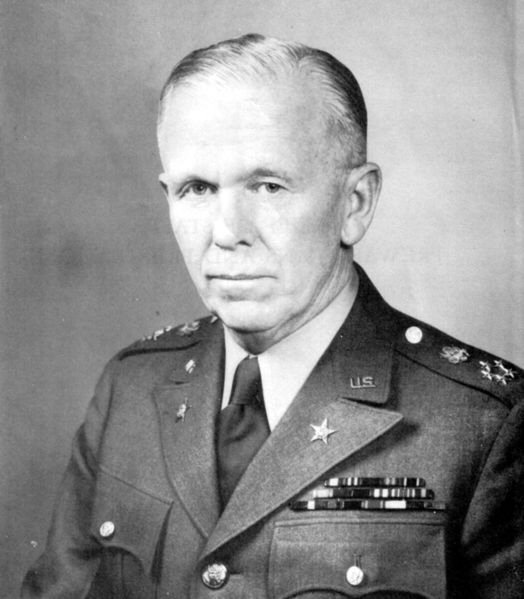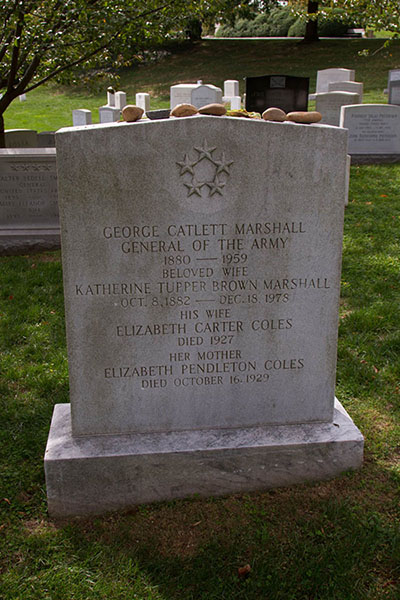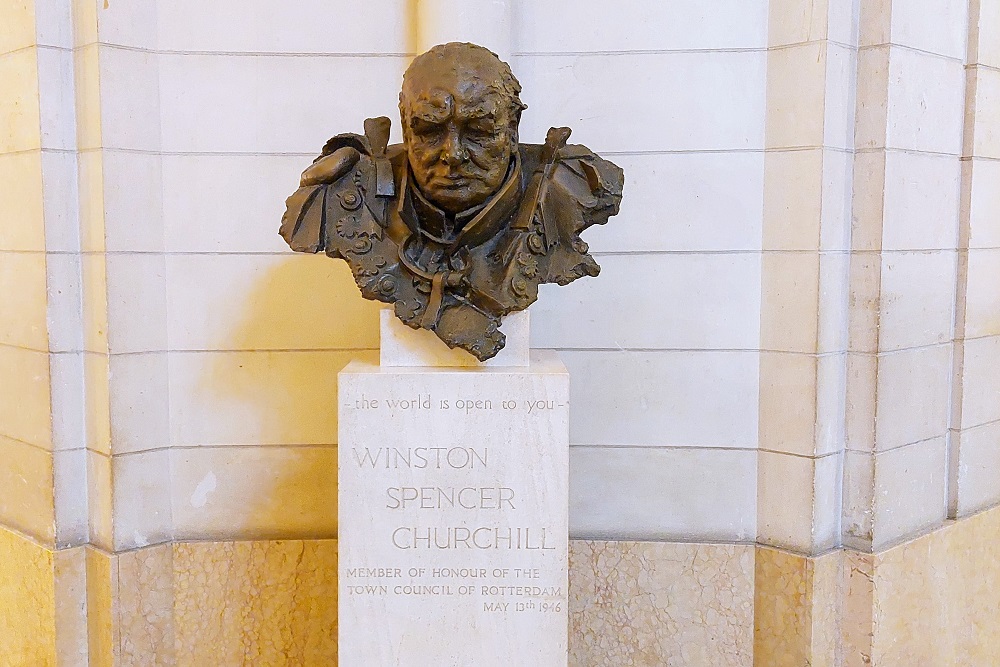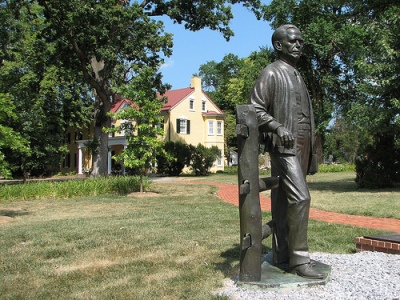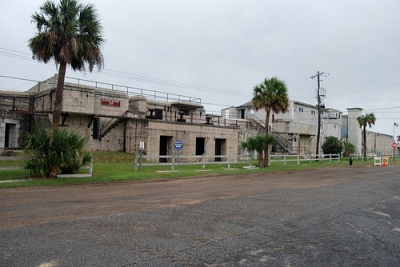Marshall, George Catlett
- Date of birth:
- December 31st, 1880 (Uniontown/Pennsylvania, United States)
- Date of death:
- September 16th, 1959 (Washington, DC, United States)
- Buried on:
- Arlington National Cemetery
Plot: 7. Grave: 8198. - Nationality:
- American
Biography
Bio
George Catlett Marshall, Jr. (born December 31, 1880 in Uniontown, Fayette Country, Pennsylvania, † October 16, 1959 in Washinton, D.C.) was an American five-star general (General of the Army) and a politician. Als stafchef van de Landmacht tijdens de Tweede Wereldoorlog coördineerde hij de Geallieerde operaties in Europa en rond de Pacific.
At the end of the war, he drafted the Marshall plan as Secretary of Foreign Affairs. This plan, officially called the European Recovery Program was intended to support the distressed Western-European countries. For this plan he was awarded the Nobel peace prize in 1953 and the Karels prize in 1959. At the end of his one-year tenure as Secretary of Defense, he retired from politics.
Military career
Marshall studied at the Virginia Military Institute and joined the U.S. Navy in 1902. In February that same year he married his childhood sweetheart Elizabeth Carter Coles. In 1907 he became Captain First Lieutenant(?) During the period up to the First World War he held several positions in America and the Philippines. During WW One he planned training as well as military operations. In 1916 he became Captain and in 1917, he was promoted to Major. That year he went to France and served in the headquarters of the American Expeditionary Force. He was instrumental in the planning and organization of the Meuse-Argonne offensive near Verdun in the fall of 1918. This offensive forced the Germans to sue for peace.
In 1919, he became adjutant to John Pershing who was General of the Armies of America at the time. Between 1920 and 1924, Marshall served in various positions in the American Army and he focused on training for modern warfare. Between 1924 and 1927 he was stationed in Tientsin, China and […..] at the Infantry School in Fort Benning, Georgia. In 1923 he was promoted to Lieutenant Colonel, to Colonel in 1933 and to Brigadier General in 1936.
In 1939, Marshall was promoted to 4-star general by President Franklin D. Roosevelt and he appointed him Chief Staff of the Army. He retained this position until the end of the war. Marshall remodeled the American Army and prepared it for war. Marshall promoted Dwight D. Eisenhower to Supreme Commander Allied Expeditionary Force and planned Operation Roundup, the predecessor of the futute Operation Overlord, the invasion in Normandy. During the Second World War, Marshall coordinated all Allied operations in Europe as well as in the Pacific region. Winston Churchill called him the organizer of the Allied victory. Time Magazine made him Man of the Year in 1943.
On December 16, 1944, he was promoted to 5-star general. After the end of the war, he was sent to China to negotiate a cease fire between the Nationalists and the Communists. In this he failed and he was sent back to America in 1947.
In 1959, Marshall passed away in Walter-Reed hospital in Washington D.C. and he was buried in Arlington National Cemetery
Do you have more information about this person? Inform us!
- Period:
- First World War (1914-1918)
- Rank:
- Colonel
- Unit:
- Assistant Chief of Staff, G-3, HQ, 1st Division, American Expeditionary Forces (AEF), U.S. Army
- Awarded on:
- 1919
War Department, General Orders No. 116
- Period:
- First World War (1914-1918)
- Rank:
- Colonel
- Unit:
- HQ, 1st Division, American Expeditionary Forces (AEF), U.S. Army
- Awarded on:
- 1919
- Period:
- First World War (1914-1918)
- Rank:
- Colonel
- Unit:
- HQ, 1st Division, American Expeditionary Forces (AEF), U.S. Army
- Awarded on:
- 1919
w/ Palm
- Rank:
- Temporary General
- Unit:
- Chief of staff of the Army (CSA), U.S. Secretary of War, U.S. Department of War, U.S. Government
- Awarded on:
- 1939
Presented by General Francisco José Pinto on behalf of President Getulio Vargas on 3 June 1939
- Period:
- Second World War (1939-1945)
- Rank:
- General
- Unit:
- Chief of staff of the Army (CSA), U.S. Secretary of War, U.S. Department of War, U.S. Government
- Awarded on:
- 1943
- Period:
- Second World War (1939-1945)
- Rank:
- General
- Unit:
- Chief of staff of the Army (CSA), U.S. Secretary of War, U.S. Department of War, U.S. Government
- Awarded on:
- March 24th, 1944
- Period:
- Second World War (1939-1945)
- Rank:
- General
- Unit:
- Chief of staff of the Army (CSA), U.S. Secretary of War, U.S. Department of War, U.S. Government
- Awarded on:
- August 26th, 1945
Presented by Charles de Gaulle at the French Embassy in D.C.
- Period:
- Second World War (1939-1945)
- Rank:
- General
- Unit:
- Chief of staff of the Army (CSA), U.S. Secretary of War, U.S. Department of War, U.S. Government
- Awarded on:
- August 26th, 1945
- Period:
- Second World War (1939-1945)
- Rank:
- General
- Unit:
- Chief of staff of the Army (CSA), U.S. Secretary of War, U.S. Department of War, U.S. Government
- Awarded on:
- November 21st, 1945
Presented by E. F. L. Wood, 1st Earl of Halifax.
- Period:
- Second World War (1939-1945)
- Rank:
- General of the Army (Fieldmarshall)
- Awarded on:
- March 22nd, 1946
- Period:
- Second World War (1939-1945)
- Rank:
- General of the Army (Fieldmarshall)
- Unit:
- Chief of staff of the Army (CSA), U.S. Secretary of War, U.S. Department of War, U.S. Government
- Awarded on:
- December 4th, 1946
Royal decree no.2
- Period:
- Second World War (1939-1945)
- Rank:
- General of the Army (Fieldmarshall)
- Unit:
- Chief of staff of the Army (CSA), U.S. Secretary of War, U.S. Department of War, U.S. Government
- Awarded on:
- 1946
War Department, General Orders No. 18. This award was obtained in the form of an Oak Leave to be attached on the ribbon of the first award received in 1919.
- Period:
- Second World War (1939-1945)
- Rank:
- General of the Army (Fieldmarshall)
- Awarded on:
- 1948
- Period:
- Second World War (1939-1945)
- Rank:
- General of the Army (Fieldmarshall)
- Unit:
- U.S. Secretary of State, U.S. Department of State, U.S. Government
- Awarded on:
- 1953
- Period:
- Second World War (1939-1945)
- Period:
- Second World War (1939-1945)
- Period:
- Second World War (1939-1945)
- Period:
- Second World War (1939-1945)
- Period:
- First World War (1914-1918)
- Rank:
- Colonel
- Unit:
- HQ, 1st Division, American Expeditionary Forces (AEF), U.S. Army
- Period:
- First World War (1914-1918)
- Period:
- First World War (1914-1918)
4 Service Clasps: Aisne-Marne Offensive, Battle of St. Mihiel, Meuse-Argonne Offensive, Defensive Sector
- Period:
- First World War (1914-1918)
- Period:
- Second World War (1939-1945)
- Period:
- Second World War (1939-1945)
- Period:
- Second World War (1939-1945)



























